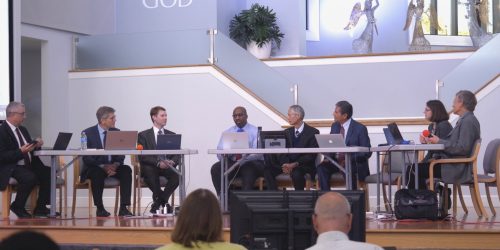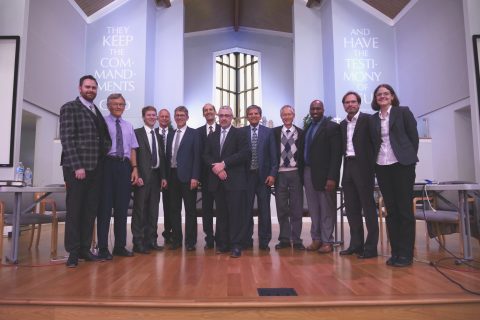
Panel of Hebrew scholars discussing Daniel 11 divergence and anchor texts | Photos by Jonathan Min
The 2019 Daniel 11 Symposium, hosted by the Berrien Springs Village Church, presented an opportunity for further understanding of a difficult prophetic passage.
The Oct. 17 – 19 event brought a dynamic blend of scholars with expertise in biblical Hebrew, as well as laypeople without formal training. Each day included multiple time segments set aside for singing, praying, and seeking God together. A beautiful spirit was sensed between participants—people from opposing viewpoints drawn together by a bond much deeper than their interpretation of Daniel 11.
The opening presentations on Thursday morning — by Kim Kjaer, a retired pastor and Brendan Valiant, a lay person who has done a lot of studying and writing on the topic — explained two different hermeneutical methods for interpreting Daniel 11.
In the afternoon, Seventh-day Adventist Theological Seminary Professor, Denis Fortin, gave a survey of interpretative approaches that Adventists have used from William Miller’s time to the present. Retired White Estate administrator, William Fagal’s presentation answered question regarding the extent to which Ellen White endorsed Uriah Smith’s interpretation.
The roundtable discussion on Friday and Sabbath focused on understanding the language of the Hebrew text. The forum involved professors from Andrews University, Oakwood University, and Austria’s Bogenhofen Theological Seminary.

The three basic Adventist interpretations of the book of Daniel 11 discussed were:
The Turkey and Egypt position:
The first view holds fairly closely to what Uriah Smith wrote in Daniel and Revelation and defends a strong literal interpretation throughout the entire chapter. The King of the North in verses 40-45 is interpreted as being Turkey, either as the Ottoman Empire in its conflict in 1798AD with Napoleonic France and the breakaway rulers of Egypt (verses 40-44) or as a last-days reincarnation of the Caliphate, while the King of the South in verses 40-45 represents Egypt. The Uriah Smith interpretation argues that all the verses up to and including verse 44 have been fulfilled. The modern exponents of this position argue that verse 45 is to be interpreted as Turkey, leading a re-established Caliphate, which will establish a newly restored Caliphate in Jerusalem, after which this power meets its end, leading to the final time of trouble of Daniel 12:1. This position has many adherents because: a) it appears to use a consistent literal hermeneutic (principle of interpretation) throughout the chapter, i.e. the King of the North is always a literal, earthly power situated / based to the north of Jerusalem, and the King of the South is always a literal, earthly power situated / based to the south of Jerusalem; and b) Ellen G. White appears to provide strong support for the views contained in Uriah Smith’s preaching on the “Eastern Question” and the contents of his chapter on Daniel 11 in his book, Daniel and Revelation. It should be noted that some recent Adventist commentators cast doubt on the extent of her support for this interpretation.
The Papacy and Atheism position:
The second position takes the latter half of the chapter symbolically, arguing that the Papacy is represented in its persecuting phase during the 1,260 years of Papal supremacy. This position agrees with the literal / historical interpretive framework for verses 1-22, down to the death of Jesus Christ on Calvary, but argues that after Calvary, the New Testament (OT) consistently applies a more spiritualized interpretation of Old Testament (OT) literal actors, e.g. historical Babylon in Daniel becomes spiritual Babylon in Revelation, ethnic Israel through the OT era to the end of the 490 year prophecy of Daniel times then becomes spiritual Israel in NT times etc. Thus, although this position identifies historical actors from verse 23 onwards, these historical actors are no longer considered to represent the literal earthly powers to the north and south of Jerusalem, but spiritual powers that are manifest in earthly realities, e.g. the Papacy as the King of the North. Verses 36-39 represent the full flowering of the blasphemous and persecuting Papal power prior to 1798AD. In verses 40-45, the Papacy remains as the King of the North and Atheism as the King of the South. This position parallels the identification of the atheist French Revolution in Revelation 11, and Revolutionary France being the power that overthrew the Papacy in 1798AD. This view came into vogue from the 1940s onwards after the writings of Louis Were, and is driven by two main factors: 1) literary parallels between the little-horn Papal power of Daniel 7 and 8 with the King of the North from verse 36 onwards; 2) seeking to correlate the eschatology of Revelation 12-14 and 2 Thessalonians, with the actors mentioned in Daniel 11. This view is probably the most commonly held view in the Adventist church today.
The Papacy and Islam position:
The third (and most recent) position among Adventists reads Daniel 11 as the third basically literal interpretation of the symbolic vision in 8:1-14, after the interpretations in 8:17-26 and 9:24-27. Daniel 11:2-21 profile a sequence of historical events after the time of Daniel that affect his Jewish people and comprise background to the Messiah’s coming. Verse 22 predicts the death of Christ under imperial Rome at the heart of the chapter. Verses 23-30 trace the rise of the religious-political church of Rome and its political-military exploits, including the Crusades and later campaigns against Islamic power, in which Catholic forces coming to the land of Israel from the north and Muslim armies coming to it from the south sought to control it (verses 25-30). Then verses 31-39 flesh out the predictions in Daniel 7 and 8 concerning the papacy’s unique and astonishing religious pretensions and vicious persecutions (verses 31-39; see also 2 Thessalonians 2). In verses 40-43, the papacy and its allies (“Babylon” in Revelation) finally triumph over Islamic power, its long-time religious-political nemesis (see also the 5th and 6th trumpets in Revelation 9), during the “time of the end” (after 1798 and 1844). But in the course of a final campaign, apparently to persecute God’s true people, the papacy abruptly meets its end (verses 44-45) just before a “time of trouble” and Christ’s second coming (12:1-3). This interpretation accepts religious emphasis and globalization developing after Christ’s first coming as Israel becomes the Christian church and Rome becomes the papacy. However, God’s true Christian people are also affected by political-military activities of Rome and Islam at particular times and locations.
This year’s event was livestreamed; archival material can be viewed at youtube.com/villagemediaministry. Papers and resources from this year’s and also last year’s conferences are available at www.daniel11prophecy.com.
The steering committee, chaired by Village Church member Conrad Vine, is planning to go further in the prophetic studies at next year’s Daniel 11 event, which is scheduled for Oct 22-24.
_________
Joe Reeves, associate pastor, Berrien Springs Village Church